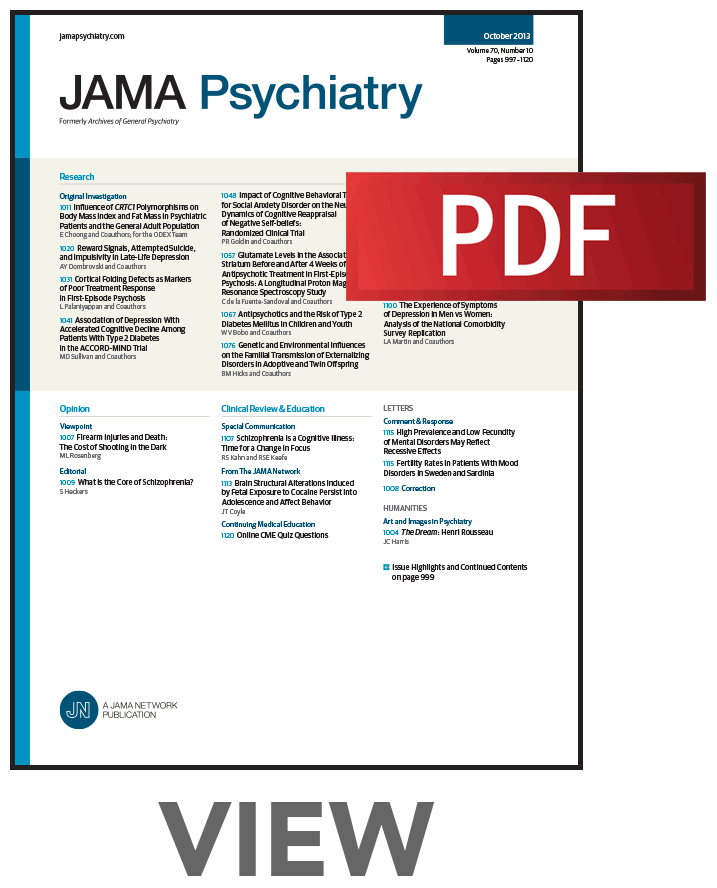随着时间的推移,注意力缺陷/多动障碍药物处方的增加和现实世界的结果。
IF 17.1
1区 医学
Q1 PSYCHIATRY
引用次数: 0
摘要
在过去的20年里,许多国家的注意力缺陷/多动障碍(ADHD)药物处方大幅增加。然而,ADHD药物的实际益处是否会随着社会中处方率的增加而改变,仍然是未知的。目的研究ADHD药物与现实世界结果(自残、意外伤害、交通事故和犯罪)之间的关联是否随着处方率的上升而改变。设计、环境和参与者本研究采用自我对照病例系列设计。这是一项基于人群的研究,使用瑞典国家登记册,包括2006年至2020年间在瑞典使用ADHD药物的个人。数据分析时间为2023年10月至2024年11月。药物使用。服药期间与非服药期间自残、意外伤害、交通事故和犯罪的发生率。在2006年至2010年、2011年至2015年和2016年至2020年三个时间段内,ADHD药物治疗与这些现实世界结果之间的关系进行了研究,在此期间,ADHD药物治疗的患病率从0.6%上升到2.8%。结果2006 - 2020年,瑞典共发现4 ~ 64岁使用ADHD药物的247 420例(女性99 361例[40.2%],男性148 059例[59.8%])。ADHD药物治疗始终与较低的自我伤害风险相关(发病率比[IRR]从0.77;95% CI, 0.73-0.81 ~ 0.85;95% CI, 0.82-0.88),非故意伤害(IRR从0.87;95% CI, 0.84-0.89 ~ 0.93, 95% CI, 0.91-0.95),交通事故(IRR范围为0.71;95% CI, 0.67-0.77 ~ 0.87;95% CI, 0.83-0.91)和犯罪(IRR范围从0.73;95% CI, 0.71-0.75至0.84;95% CI, 0.82-0.85),不同年龄、性别和时间。然而,随着处方率的增加,ADHD药物使用与意外伤害(趋势P值< 0.01)、交通事故(趋势P值< 0.01)和犯罪(趋势P值< 0.01)风险降低之间的关联似乎随着时间的推移而减弱。接受ADHD药物治疗的个体的年龄和性别分布的变化并不能完全解释意外伤害和交通事故的减弱趋势。结论和相关性在这项研究中,ADHD药物仍然与降低几种严重现实结果的风险相关。然而,随着时间的推移,这些关联的程度似乎随着处方率的上升而下降。因此,定期评估不同患者群体的用药情况是很重要的。本文章由计算机程序翻译,如有差异,请以英文原文为准。
Increased Prescribing of Attention-Deficit/Hyperactivity Disorder Medication and Real-World Outcomes Over Time.
Importance
The prescription of attention-deficit/hyperactivity disorder (ADHD) medications has risen substantially in many countries over the last 20 years. However, whether the real-world benefits of ADHD medications change with increased prescription rates within a society remains unknown.
Objective
To examine whether the associations between ADHD medications and real-world outcomes (self-harm, unintentional injury, traffic crashes, and crime) change as prescription rates rise.
Design, Setting, and Participants
This study used a self-controlled case series design. It was a population-based study using Swedish National Registers that included individuals who used ADHD medications in Sweden between 2006 and 2020. Data were analyzed from October 2023 to November 2024.
Exposure
ADHD medication use.
Main Outcomes and Measures
Rates of self-harm, unintentional injury, traffic crashes, and crime during medicated vs nonmedicated periods. The associations between ADHD medication and these real-world outcomes were examined across 3 time periods, 2006 to 2010, 2011 to 2015, and 2016 to 2020, during which ADHD medication prevalence increased from 0.6% to 2.8%.
Results
There were 247 420 individuals identified (99 361 females [40.2%] and 148 059 males [59.8%]) aged 4 to 64 years in Sweden who used ADHD medications between 2006 and 2020. ADHD medication was consistently associated with lower risks for self-harm (incidence rate ratio [IRR] ranged from 0.77; 95% CI, 0.73-0.81 to 0.85; 95% CI, 0.82-0.88), unintentional injury (IRR ranged from 0.87; 95% CI, 0.84-0.89 to 0.93, 95% CI, 0.91-0.95), traffic crashes (IRR ranged from 0.71; 95% CI, 0.67-0.77 to 0.87; 95% CI, 0.83-0.91), and crime (IRR ranged from 0.73; 95% CI, 0.71-0.75 to 0.84; 95% CI, 0.82-0.85) across different age groups, sexes, and over time. However, the associations between ADHD medication use and lower risks of unintentional injury (P value for trend < .01), traffic crashes (P value for trend < .01), and crime (P value for trend < .01) appear to weaken over time as prescription rates increased. Changes in age and sex distribution of individuals receiving ADHD medication did not fully explain the weakening trend for unintentional injury and traffic crashes.
Conclusions and Relevance
In this study, ADHD medication remained associated with reduced risks of several serious real-world outcomes. However, the magnitude of these associations appears to have decreased alongside rising prescription rates over time. Thus, it is important to regularly evaluate medication use in different patient populations.
求助全文
通过发布文献求助,成功后即可免费获取论文全文。
去求助
来源期刊

JAMA Psychiatry
PSYCHIATRY-
CiteScore
30.60
自引率
1.90%
发文量
233
期刊介绍:
JAMA Psychiatry is a global, peer-reviewed journal catering to clinicians, scholars, and research scientists in psychiatry, mental health, behavioral science, and related fields. The Archives of Neurology & Psychiatry originated in 1919, splitting into two journals in 1959: Archives of Neurology and Archives of General Psychiatry. In 2013, these evolved into JAMA Neurology and JAMA Psychiatry, respectively. JAMA Psychiatry is affiliated with the JAMA Network, a group of peer-reviewed medical and specialty publications.
 求助内容:
求助内容: 应助结果提醒方式:
应助结果提醒方式:


